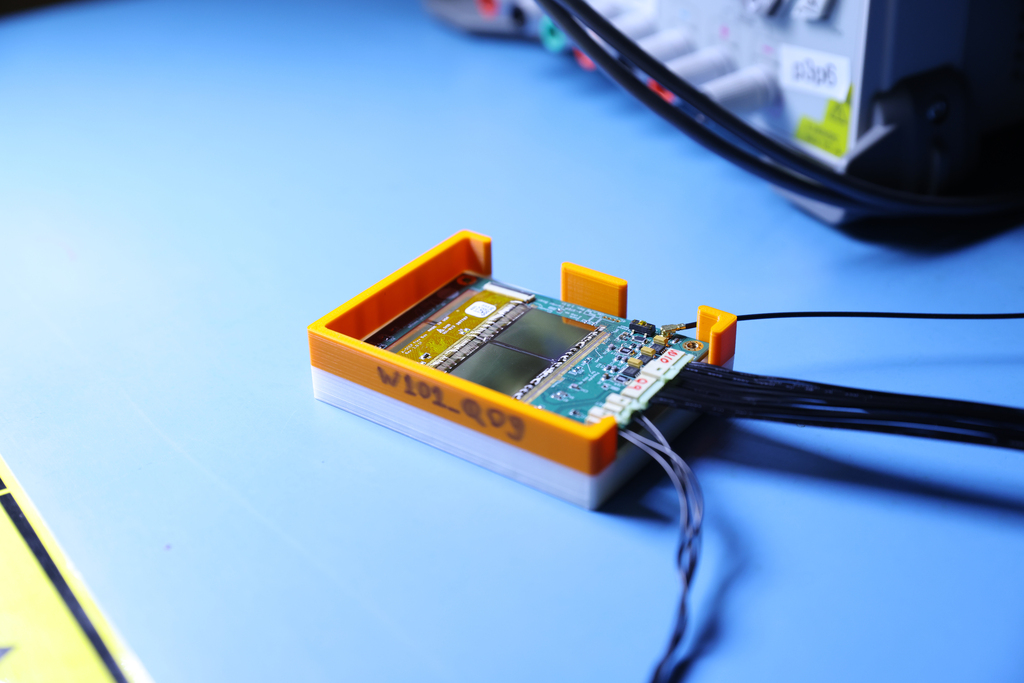Testing AstroPix, A New Gamma-Ray Detector

An AstroPix detector board rests inside a protective tray in a lab at NASA’s Goddard Space Flight Center in Greenbelt, Maryland. The squares in the center are silicon pixel gamma-ray sensors. There are two more under the rectangular copper bus bar, which carries data from the sensors to rest of the A-STEP system. The detector connects to a high-power voltage board and other electronics.
Credit: NASA/Sophia Roberts
Alt text: Electronic components rest on a lab table
Image description: What looks like a large computer chip — an AstroPix detector — rests inside a white tray on a blue lab bench. The detector is green and has two reflective squares in the middle with a long copper rectangle at right parallel to them. Black wires attached to the bottom of the chip connect it to other pieces of equipment and circuit boards on the lab bench.
Astrophysicists at NASA’s Goddard Space Flight Center in Greenbelt, Maryland, tested pre-flight versions of a new detector called AstroPix, part of an upcoming rocket payload called A-STEP (AstroPix Sounding Rocket Technology dEmonstration Payload).
AstroPix measures gamma rays, the highest-energy form of light. Each instrument board contains four AstroPix silicon sensors, and each sensor incorporates 1,225 pixels. They function similarly to the image sensors in cell phones.
A-STEP will carry a stack of three AstroPix detector boards to the edge of space on the SubTEC-10 sounding rocket, which will launch in 2026 from NASA’s Wallops Flight Facility in Virginia. The A-STEP team’s primary goal is to successfully operate the detectors, with a secondary aim of measuring the rate of impacts from cosmic rays, high-energy particles from space.

A-STEP will house a stack of three AstroPix detector boards when it flies to the edge of space on a sounding rocket in 2026. Lab testing at NASA Goddard helps ensure the team will be able to make the most of their 10-minute flight.
Credit: NASA/Sophia Roberts
Alt text: Electronic components rest on a lab table
Image description: What looks like a large computer chip — an AstroPix detector — rests inside a white tray on a blue lab bench. Black wires attached to the bottom of the chip connect it to other pieces of electronics on the lab bench. They all connect to a gray piece of equipment covered in knobs and buttons on the far side of the bench. There is a red and white sign above the gray piece of equipment. The writing is blurry, but says, “PLEASE DO NOT STARTLE THE CHIPS.”

Adrien Laviron, a postdoctoral fellow at NASA Goddard, shows off an AstroPix detector during a break in testing.
Credit: NASA/Sophia Roberts
Alt text: A man holds up two pieces of electronics
Image description: A man in a long-sleeve blue shirt holds up two electrical components and tilts them toward the camera. Each piece has wires attached. The man holds the electronics over a blue lab table with a piece of yellow caution tape running along the edge. There are shelves above the table and a computer at the far end.

Engineers at NASA Wallops designed and printed a plastic 3D model of A-STEP’s housing for use during initial testing at Goddard. The model helps the A-STEP team determine if there will be enough room not only for the science equipment but also all the necessary wires and other components.
Credit: NASA/Sophia Roberts
Alt text: A black box on a lab table
Image description: A black box sits on a blue lab table. The box has rounded protrusions at the corners and fine striations that show it was 3D printed. The side facing the camera has two connector pins near the bottom and a rectangular opening in the upper left corner that reveals a shiny copper panel inside the box.

Inside the housing, the A-STEP team placed a stack of three AstroPix detector boards, the onboard flight computer, and other components.
Credit: NASA/Sophia Roberts
Alt text: A person holds a box with electrical components inside
Image description: A person in a blue-and-yellow checkered long-sleeve shirt, seen from the neck down, holds a black plastic box. Inside the box are what look like green and red circuit boards. To the left of the person holding the box is a blue table.

Dan Violette, a postdoctoral fellow at NASA Goddard, rotates the A-STEP mockup during a break in testing.
Credit: NASA/Sophia Roberts
Alt text: A man in a lab with a black box
Image description: A man in a yellow-and-blue checkered long-sleeve shirt sits at a blue table in a lab. He rests one hand on the back of a black box with rounded protrusions at the corners and a square opening in the side facing the camera. The opening shows a copper panel inside the box.
Credits
Please give credit for this item to:
NASA's Goddard Space Flight Center. However, indvidual items should be credited as indicated above.
-
Science writer
- Jeanette Kazmierczak (University of Maryland College Park)
-
Photographer
- Sophia Roberts (eMITS)
-
Producers
- Scott Wiessinger (eMITS)
- Sophia Roberts (eMITS)
- Jeanette Kazmierczak (University of Maryland College Park)
-
Scientists
- Dan Violette
- Regina Caputo (NASA/GSFC)
Release date
This page was originally published on Monday, March 24, 2025.
This page was last updated on Monday, March 24, 2025 at 10:06 AM EDT.
